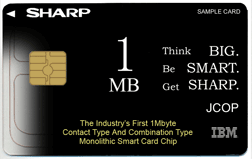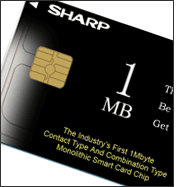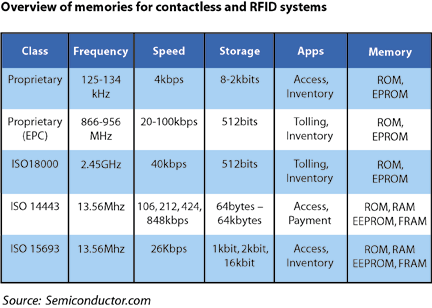Boy how times have changed: Sharp offers 1 Megabyte chip with Java Card OS
27 April, 2005
category: Digital ID, Library
 “For the last couple of years,” says Robert Stuart, Product Manager at Sharp Microelectronics of the Americas, “smart cards have had to compromise on application capability due to size constraints in integrated circuits (ICs).”
“For the last couple of years,” says Robert Stuart, Product Manager at Sharp Microelectronics of the Americas, “smart cards have had to compromise on application capability due to size constraints in integrated circuits (ICs).”
Mr. Stuart believes that this compromise is no longer necessary. That is because in May 2005 Sharp will launch a new version of its 1 Megabyte (MB) smart card with the Java Card Open Platform (JCOP) operating system.
Is this significant? It could be very significant because the support for JCOP is certain to gain the attention of major card issuers currently using cards that rely on JavaCard™ technology. Issuers such as government agencies, passport offices, financial institutions, and more (note: To date, JCOP has been primarily used for Visa-issued financial cards using ICs from Philips.)
 The 1 MB chip is not new. “For a long time, we have been the only high capacity, multi-application large volume flash offering,” says Mr. Stuart. But it has been a relatively niche product used only in a select number of demanding projects. According to Mr. Stuart, “More than 2 million have been issued for national ID cards in Japan, with Japan and Australia are issuing them in passport trials.”
The 1 MB chip is not new. “For a long time, we have been the only high capacity, multi-application large volume flash offering,” says Mr. Stuart. But it has been a relatively niche product used only in a select number of demanding projects. According to Mr. Stuart, “More than 2 million have been issued for national ID cards in Japan, with Japan and Australia are issuing them in passport trials.”
What is new is the JCOP offering. “We have many customers waiting on the JCOP 31 completion for issuance,” he adds.
So what is JCOP?
According to Michael Baentich, author of JCOP: A cross industry value proposition, “JCOP is the open IBM smart card operating system based on open, third-party standards, such as Java, GlobalPlatform, ISO, PKCS, and others.” ( click here to read the JCOP document )
It is an IBM-developed technology that incorporates several industry standard technologies together: the JavaCard™ platform from Sun Microsystems, the Global Platform 2.1.1 specifications, and the Visa Global Platform standard for financial cards. JCOP also supports Advanced Encryption Standard (AES) and Elliptic Curve Cryptosystem (ECC) technologies.
Sharp and the smart card marketplace
Sharp Microelectronics of the Americas is a part of the Sharp Corporation of Osaka, Japan. The company has been in the smart card industry since the late 1990s. “We are primarily a silicon engine that enables people to host multiple applications,” says Mr. Stuart. “We don’t make cards, we provide modules. The customer can buy modules to embed or they can select a card manufacturer from a list of approved suppliers.”
Because the Sharp chips are not embedded by the traditional, major smart card manufacturers, the company does foray beyond the typical module supplier role. Says Mr. Stuart, “we are doing both the role of silicon and sales because the (supply) chain is a bit different.”
The new Sharp chip is the 16-bit Java Card™ OS Smart Card. It has dual interface to support both contact and contactless (ISO 14443 Type B) utilization. In addition to the 1 MB Flash memory capacity, it is also available in both 128 kB and 512 kB sizes.
 What is Flash memory?
What is Flash memory?
Traditionally, smart cards have utilized electrically erasable programmable read-only memory (EEPROM). Flash is another variation of memory that is similar to EEPROM. Each type has its advantages and disadvantages as well as its supporters and critics.
Both EEPROM and Flash are non-volatile solid-state memory. “Flash requires just one-quarter the size (surface area of silicon) for the equivalent memory capacity of EEPROM,” says Mr. Stuart. Flash is erased in blocks rather than bit-by-bit or byte-by-byte so it can offer a faster cycling time for read/write transactions. And, adds Mr. Stuart, “flash allows us to do real-time development … dynamically developing in a period of weeks or months. Far shorter than the mask creation process for EEPROM.”
But others point to the drawbacks for flash memory. Though read/write cycles are faster for flash, read cycles have traditionally been slower. Additionally, when it comes to smart card ICs, EEPROM is a more mature technology with much higher sales volumes. Thus the cost for flash has been higher.
Conclusion
As the new JCOP-ready chips become available, we will see if other project leaders see enough benefit in the high capacity ICs to make the change from EEPROM to flash and spend the extra money to gain the additional memory. As Mr. Stuart is quick to point out, up-front costs are less important than life-of-product costs. “With this, the memory is there. After you have re-issued several times (with lower capacity cards), the high capacity option becomes very cost effective.”
Additional resources:
To visit Sharp Microelectronics of the Americas on the web, click here.



